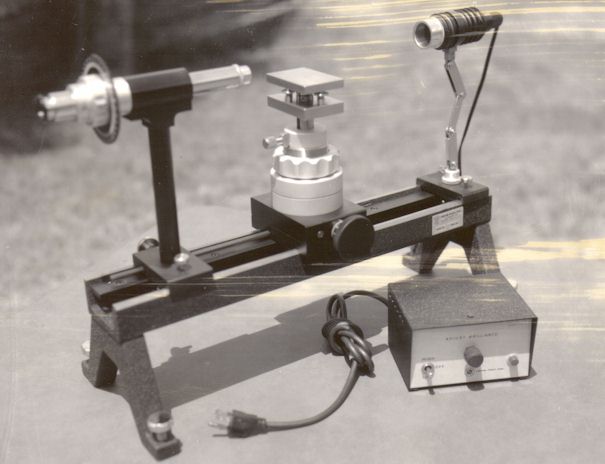|
January 2019 |
|
| A Brief History of Goniometry (and Surface Tension) | |
| Leonardo da Vinci in the 15th
century understood "tenacity". That's what he called surface
tension. In a section of his Codex Leicester (now owned by Bill
Gates), there is a section of notes which was to become his "Book
of Water", a work that was never completed. Here he wrote,
“That water may have tenacity and cohesion together is quite clearly shown in small quantities of water, where the drop, in the process of separating itself from the rest, before it falls becomes as elongated as possible, until the weight of the drop renders the tenacity by which it is suspended so thin that this tenacity, overcome by the excessive weight, suddenly yields and breaks and becomes separated from the drop, and returns upward contrary to the natural course of its gravity…”.
It's clear that in addition to surface tension, da Vinci had a firm grasp of capillary rise forces. It's too bad he never got to finish his "Book of Water". Surely, there would have been a chapter on contact angle and wetting. In 1629, during the early dawn of the Enlightenment, Niccolò Cabeo, in his Philosophia Magnetica, explored da Vinci's observations of surface tension. He clearly understood the phenomenon but was unable to express it in terms of forces or equation.
Less than a decade later in 1638, Galileo in his Discourses about Two New Sciences, asks, "How is it possible for those large drops of water to stand out in relief upon cabbage leaves without scattering or spreading out?" It's fortuitous that Galileo was musing over a plant that would later be studied for its superhydrophobic properties.
While Galileo was onto something, he didn't pursue it. And it wasn't until 167 years later that Thomas Young in his 1805 essay "On the Cohesion of Fluids" that the theory of wetting was first detailed. And while Young did not present any formulas, he did give a written description of what would later be called Young's Equation which explains the equilibrium of forces at the three-phase line. This was a seminal moment in contact angle history and one that is still often referenced by scientist who study wetting.
In 1891, a self-taught Italian-born German woman by the name of Agnes Pockels published a paper on surface tension based initially on observations made while washing dishes at home. She developed a slide trough for measuring surface tension, an instrument that was later developed by Irving Langmuir, an American chemist and Katharine Blodgett, an American physicist, and called the Langmuir-Blodgett trough. In 1936, R. N. Wenzel in his Resistance of Solid Surfaces to Wetting by Water describes how roughness affects contact angle and correctly concludes that roughness will amplify the natural inclination of a surface - i.e., roughness makes a hydrophilic surface even more hydrophilic while making a hydrophobic surface more hydrophobic. When a drop sits fully in the nooks and crannies of a surface, it's said to be in a Wenzel state. In 1944, A. B. D. Cassie and S. Baxter in their Wettability of Porous Surfaces paper, describe mathematically the contact angle of a drop on a rough surface when it sits on the tips of the topology with air in the nooks and crannies below. This condition, known as the Cassie-Baxter state, explains how surfaces can be made to be superhydrophobic, a topic of study that has drawn the intense interest of surface scientist in recent years.
In 1949, W. A. Zisman, while serving as the Superintendent of the Chemistry Division of the US Naval Research Lab (NRL), designed the NRL Contact Angle Goniometer in order to more closely study wetting phenomena. In the early 1960s George Meyer, then a founding partner at ramé-hart, met with Dr. Zisman and was granted permission to produce in volume the NRL Goniometer. The Model A-100 which later became the Model 100-00 went on to become the single most successful contact angle goniometer in history. Thousands of these manual microscope-based instruments were sold by ramé-hart for a span exceeding four decades. Today there are many still in use and others that have been upgraded with camera and software. In 1964, Rulon E. Johnson, Jr. and Robert H. Dettre published the first paper on contact angle hysteresis. Their research was a springboard for the work of Wilhelm Barthlott and N. Ehler who studied superhydrophobic surfaces. They coined the term "Lotus Effect" and published their research in 1977. It wasn't until the 1990s that superhydrophobicity began to gain a high level of interest from the surface science research community.
Also, in the 1990s, ramé-hart introduced the first camera-based software-driven contact angle goniometer. The classic NRL design lives on in today's models which are all highly-developed software-driven tools offering contact angle, surface energy, and surface tension tools. Accessories like the Automated Tilting Base and Automated Dispensing System make it easy to perform advancing and receding contact angle measurements. The future of contact angle and
wetting phenomena promises to solve questions that have been
puzzling surface scientists. At the forefront of contact angle
instrumentation, ramé-hart will continue to innovate and offer
compelling and powerful tools for the surface science community.
|
|
| Happy New Year | |
|
From all of us here at ramé-hart, we
wish all of you a happy and prosperous 2019. |
|
|
Regards,
Carl Clegg |
|






